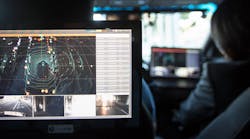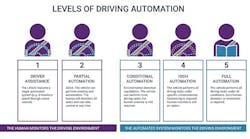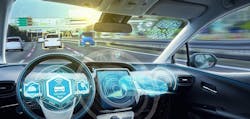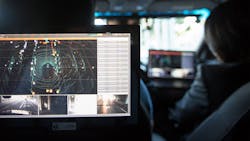Autonomous cars have been recently hitting the headlines and dominating tech-talks. They are seen as a post-Uber disruption to public commute and transportation of goods. Surely they are no figment of imagination in the age of artificial intelligence (AI), which is being used to complement driverless cars.
Companies such as Waymo and Tesla are heavily invested in driverless cars. Currently, Waymo has begun testing of driverless cars again after stopping in 2017. Testing is done with drivers inside the vehicles until the company is able to gain enough data to move towards a completely driverless solution.
But before we get into further details, let us discuss what autonomous means. SAE International has recently updated the visual chart which aims at clarifying the J3016 “Levels of Driving Automation” standard for its customers. This standard serves as a baseline for automated vehicles, and thus contains the following levels:
Automation for driver assistance. This is a preliminary level or starting point of car automation where the system assists the driver but does not take control of the car (e.g., parking sensors).
Partially automated driving. The system takes partial control, but the driver is primarily responsible for the operation of the vehicle.
Highly automated driving. This allows users to let the system take control of the vehicle for a longer duration of time (e.g., on the highway).
Fully automated driving. The system is responsible for driving the vehicle without interference from any human. However, the human presence is still needed.
Completely automated car. The vehicle can completely navigate its way through from one point to another without any assistance from a driver.
Depending on the level of automation, the definition of autonomous varies. While automation for driver assistance and partially automated cars are in commercial use, the remaining stages are still under test conditions.
For the purpose of this article, let’s discuss the impact of AI in highly automated driving, and how AI is being harnessed to bring fully autonomous driving into reality.
The Role Of AI in Complementing the Use Of Autonomous Cars
Subject to regulatory and social acceptance, the impact of completely autonomous cars is not limited to the disruption of the public transport system, but also its potential to shake other industries.
When talking about autonomous cars, it is almost impossible not to discuss artificial intelligence. AI is used to enable the cars to navigate through the traffic and handle complex situations. Also, with a combined AI software and other IoT sensors, such as cameras, it becomes easier to ensure proper and safe driving.
Having discussed the potential of AI, let’s talk about the top four areas where AI is seen as a game-changer toward the success of autonomous vehicles.
The levels of vehicle autonomy explained.
1. AI for Self-Driving Car Safety
Before AI completely takes over the driver’s seat, it is being used as a co-pilot to gain the confidence of the users, regulators, manufacturers. By analyzing data feeds across its sensors, AI can be handy in situations where flesh and blood drivers are prone to making human errors.
AI can score very high in areas such as:
- Emergency control of the vehicle
- Cross-traffic detection
- Syncing with traffic signals
- Breaking in cases of emergencies
- Active monitoring of blind spots
These features help keep the driver’s attention on the task of driving. However, the processing power needed to drive a vehicle is enormous. Without control of your external environment there are countless variables, so AI needs a lot of learning. There are numerous companies testing AI’s applicability in driving, but the most noteworthy achievements have been made by Waymo and Tesla.
Waymo’s AI algorithms are fed with real-time data from sensors, GPS, radar, lidar, cameras, and cloud services. These data are processed to produce control signals that are used to operate the car.
The future of the transport industry.
2. Curated Cloud Services Targeted for Individuals
AI can be used to accurately gauge the physical condition of the vehicle. Data gathered from the usage can be processed for both:
- Predictive maintenance
- Prescriptive maintenance
“Drivers will have an easier time finding a car warranty plan that is cost-effective and meets their particular needs, and that also reflects the car’s current condition,” say the experts of Circle Auto Shield.
3. Accurate Feed for Regulators and Insurance Companies
Data from automated cars can be used to determine traffic violations and claims. From an insurance perspective, AI can be of help to determine the:
- Driver risk assessment. Using AI, a driver’s behavior can be accurately gauged and, based on the risk profile, the cost of insurance could adjust accordingly.
- Ease of claim. Data from the vehicle can be used for faster processing of claims in case of accidents. E.G. Art Financial offers an AI-based video app, Dingsunbao 2.0, which allows users to access their auto damage by using a smartphone camera to scan the vehicle’s damage area.
3. Transition to driverless cars.
4. Monitoring the Driver and User Behavior
The applicability of AI in autonomous cars is not limited to stricter requirements, such as safety. AI can be used for a host of controls and entertainment inside the car.
AI is helpful to provide customized entertainment during the travel. Based on the data collected over time, AI can predict and prescribe preferences based on user behavior. These could include:
- Seat position adjustment
- Mirror adjustment
- Regulating the air-conditioning
- Songs to be played
AI is advancing autonomous driving for people to experience of effortless transit. Governments, too, have jumped into the race, wooing investors to bring AI-based driverless cars into commercial use.
In Aug. 2018, the British Government unveiled plans for an AI simulator, intended for the purpose of attracting companies as a favorable destination for testing self-driving cars. Named OmniCAV, the simulator can recreate a virtual version of 32km of Oxfordshire roads.
The world is changing, and AI is getting smarter every day. But while we might be around the corner from witnessing the post-Uber era, don’t hold your breath: fully autonomous driving still has a long road to go.




